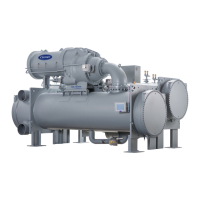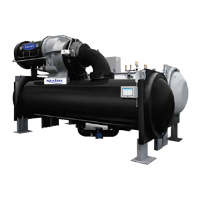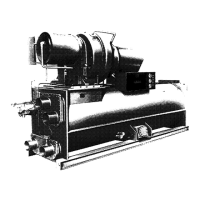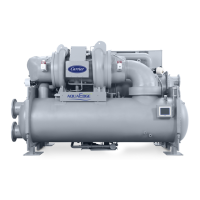2. Close the suction service valve and open the discharge
line to the storage tank or the chiller.
3. Operate the compressor until the crankcase pressure drops
to 2 psig (13 kPa).
4. Stop the compressor and isolate the system by closing
the discharge service valve.
5. Slowly remove the oil return line connection (Fig. 32).
Add oil as required.
6. Replace the connection and reopen the compressor serv-
ice valves.
OPTIONAL PUMPOUT SAFETY CONTROL SETTINGS
(Fig. 35) — The optional pumpout system high-pressure switch
opens at 161 psig (1110 kPa) and closes at 130 psig
(896 kPa). Check the switch setting by operating the pump-
out compressor and slowly throttling the pumpout con-
denser water.
Ordering Replacement Chiller Parts — When
ordering Carrier specified parts, the following information
must accompany an order:
• chiller model number and serial number
• name, quantity, and part number of the part required
• delivery address and method of shipment.
TROUBLESHOOTING GUIDE
Overview —
The PIC II has many features to help the
operator and technician troubleshoot a 19XR chiller.
• The CVC shows the chiller’s actual operating conditions
and can be viewed while the unit is running.
• The CVC default screen freezes when an alarm occurs.
The freeze enables the operator to view the chiller con-
ditions at the time of alarm. The STATUS screens con-
tinue to show current information. Once all alarms have
been cleared (by correcting the problems and pressing the
RESET
softkey), the CVC default screen returns to nor-
mal operation.
• The CONTROL ALGORITHM STATUS screens (which
include the CAPACITY, OVERRIDE, LL_MAINT,
ISM_HIST, LOADSHED, WSMDEFME, and OCCDEFCM
screens) display information that helps to diagnose prob-
lems with chilled water temperature control, chilled water
temperature control overrides, hot gas bypass, surge al-
gorithm status, and time schedule operation.
• The control test feature facilitates the proper operation and
test of temperature sensors, pressure transducers, the guide
vane actuator, oil pump, water pumps, tower control, and
other on/off outputs while the compressor is stopped. It
also has the ability to lock off the compressor and turn on
water pumps for pumpout operation. The CVC shows the
temperatures and pressures required during these
operations.
• From other SERVICE tables, the operator/technician can
access configured items, such as chilled water resets, over-
ride set points, etc.
• If an operating fault is detected, an alarm message is gen-
erated and displayed on the CVC default screen. A more
detailed message — along with a diagnostic message —
is also stored into the ALARM HISTORY table.
Checking Display Messages — The first area to check
when troubleshooting the 19XR is the CVC display. If the
alarm light is flashing, check the primary and secondary mes-
sage lines on the CVC default screen (Fig. 12). These mes-
sages will indicate where the fault is occurring. These mes-
sages contain the alarm message with a specified code. This
code or state appears with each alarm and alert message. The
ALARM HISTORY table on the CVC SERVICE menu also
contains an alarm message to further expand on the alarm.
For a complete list of possible alarm messages, see Table 8.
If the alarm light starts to flash while accessing a menu screen,
press the EXIT
softkey to return to the default screen to
read the alarm message. The STATUS screen can also be
accessed to determine where an alarm exists.
Checking Temperature Sensors — All tempera-
ture sensors are thermistor-type sensors. This means that the
resistance of the sensor varies with temperature. All sensors
have the same resistance characteristics. If the controls are
on, determine sensor temperature by measuring voltage drop;
if the controls are powered off, determine sensor tempera-
ture by measuring resistance. Compare the readings to the
values listed in Table 9A or 9B.
RESISTANCE CHECK — Turn off the control power and,
from the module, disconnect the terminal plug of the sensor
in question. With a digital ohmmeter, measure sensor resis-
tance between receptacles as designated by the wiring dia-
gram. The resistance and corresponding temperature are listed
in Table 9A or 9B. Check the resistance of both wires to
ground. This resistance should be infinite.
VOLTAGE DROP — The voltage drop across any ener-
gized sensor can be measured with a digital voltmeter while
the control is energized. Table 9A or 9B lists the relation-
ship between temperature and sensor voltage drop (volts dc
measured across the energized sensor). Exercise care when
measuring voltage to prevent damage to the sensor leads,
connector plugs, and modules. Sensors should also be checked
at the sensor plugs. Check the sensor wire at the sensor for
5 vdc if the control is powered on.
Relieve all refrigerant pressure or drain the water be-
fore replacing the temperature sensors.
Fig. 35 — Optional Pumpout System Controls
69

